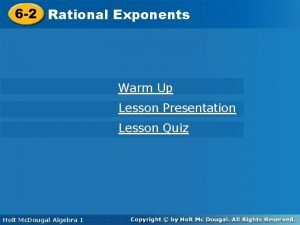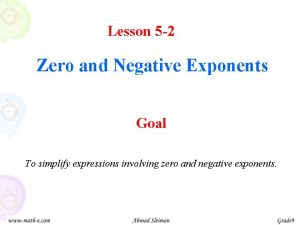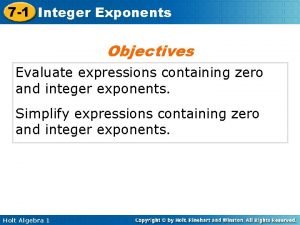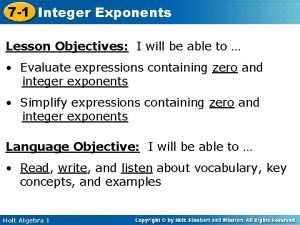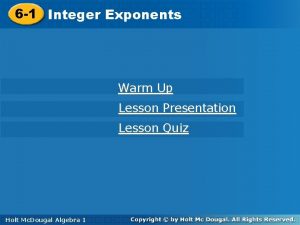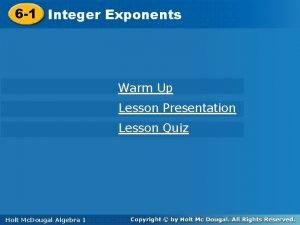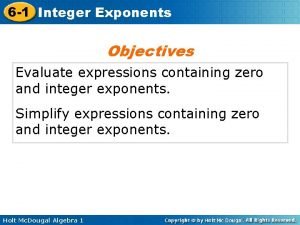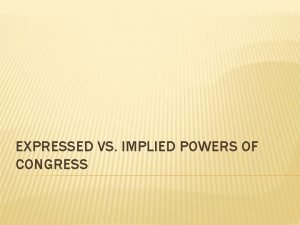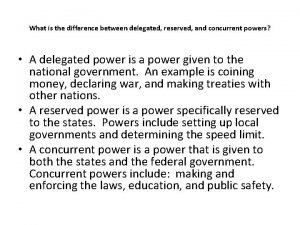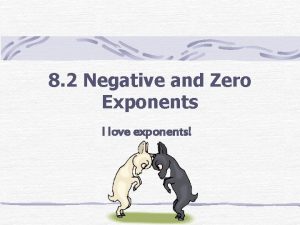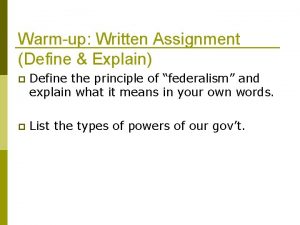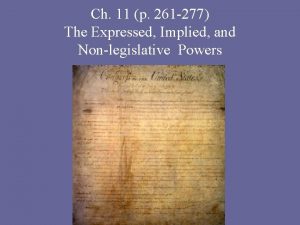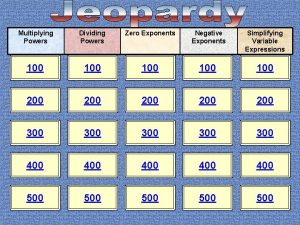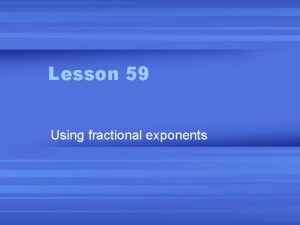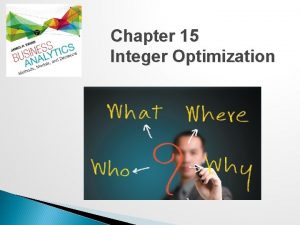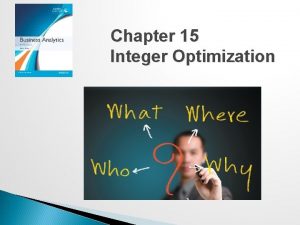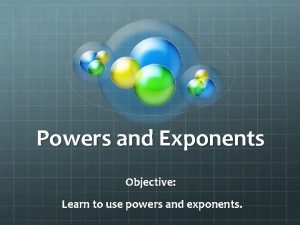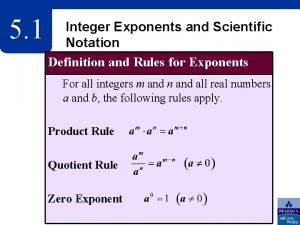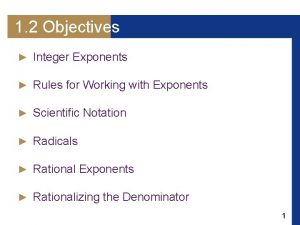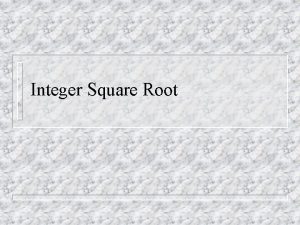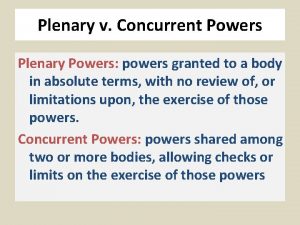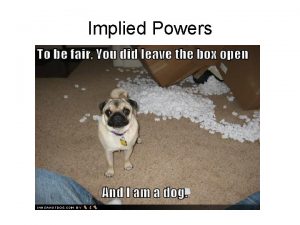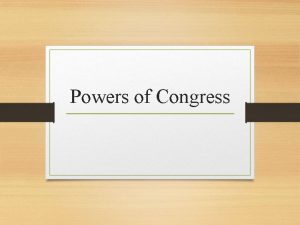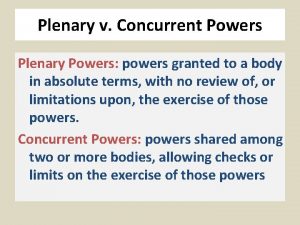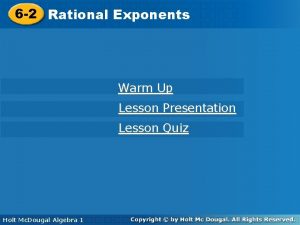Working with Powers Definition of Powers Integer Exponents





























- Slides: 29

Working with Powers • Definition of Powers • Integer Exponents • The seven Exponent Rules 1

Repeated multiplications… • 2× 2= • 2× 2× 2× 2= • How can we write these in shorter notation? 2

• For repeated addition we use multiplication 3+3+3=5× 3 • For repeated multiplication we use exponents 3× 3× 3= 3

Write these numbers using exponential notation: • 10 000 = 10? • 27 = 3? 104 33 • 32 = 2? 25 4

Computer Memory A byte is capable of storing one letter of the alphabet. For example, the word “math” requires four bytes to store in a computer. Bytes of computer memory are often manufactured in amounts equal to powers of 2. 5

For Example 1 kilobyte (1 Kb) = 210 = 1024 (about a thousand bytes) 1 megabyte (1 Mb) = 220 = 1 048 576 (about a thousand kilobytes) 1 gigabyte (1 Gb) = 230 = 1 073 741 824 (about a thousand megabytes) 6

Integer Exponents • Base 4 • Exponent 3 • 43 is called a power • 43 = 4 x 4 • = 64 You need to know what is meant by base, exponent and power. 7

You try these. . . • 72 = 49 • 4 5 = 625 • 3 4 = 64 8

Exponent Rules 1. 5. 2. 6. 3. 7. 4. These rules will be explained in the following slides 9

Exponent Rule #1 #1 Why put a 1 at the beginning? n times 5 times That’s why! 10

Exponent Rule #2 #2 Any power with an exponent of 0 is equal to 1 11

0 a = 1 • 0 4 =1 • M 0 =1 • 0 9 =1 • (pq)0 =1 • 170 =1 • (2 x 2 y)0 =1 12

Exponent Rule #3 #3 n times 4 times A negative exponents means divide 13

Negative Exponents • -1 3 • -4 2 • 7 -1 • (1/2) -1 • 5 -2 • (3/4) -2 14


Operations with Exponents Multiply: (x 3)∙(x 4) = (x ∙ x) ∙ (x ∙ x ∙ x) = (x ∙ x ∙ x ∙ x) = x 7 A 5 ∙ A 4 = A 9 Divide: = m 2 16

Multiplying Exponents m n a a =? 17

Exponent Rule #4 #4 When multiplying powers with the same base, add the exponents. 18

• x 5 x 4 = x 9 • y-2 y 7 = y 5 • b 3 b-6 = b-3 • m 6 m-6 = m 0 • (2 x 5)(4 x-3) • 2 z-1 z 5 w-6 w-2 = 8 x 2 = 2 w-8 z 4 19

Dividing Exponents 20

Exponent Rule #5 #5 When dividing powers with the same base, subtract the exponents. 21

= x 4 = y 5 22

Powering Exponents (am)n=? 23

Exponent Rule #6 #6 When taking a powers of a power (one base only), multiply the exponents. 24

• (w 4)5 = w 20 • (p-3)4 = p-12 • (5 x 4)-2 = 5 -2 x-8 • (-3 y-7)3 = -33 y-21 25

Powering Exponents 26

Exponent Rule #7 #7 Powers of products or quotients When taking a powers of a product or quotient, distribute the exponent into the bracket. 27


Exponent Rules 1. 5. 2. 6. 3. 7. 4. 29
 Keep change change integers
Keep change change integers Fraction exponents
Fraction exponents Negative exponents
Negative exponents Laws of integer exponents
Laws of integer exponents Integer exponents
Integer exponents 7-1 integer exponents
7-1 integer exponents Integer exponents
Integer exponents A number to the negative power
A number to the negative power 6-1 integer exponents
6-1 integer exponents 6-1 integer exponents
6-1 integer exponents Evaluating expressions with exponents quiz
Evaluating expressions with exponents quiz How to simplify integer exponents
How to simplify integer exponents Exponent
Exponent Hard work and smart work
Hard work and smart work Hot and cold working process
Hot and cold working process Hot working and cold working difference
Hot working and cold working difference Differentiate between hot working and cold working
Differentiate between hot working and cold working Proses hot working
Proses hot working Was the united states on the axis powers or allied powers?
Was the united states on the axis powers or allied powers? What were the 4 main causes of wwi
What were the 4 main causes of wwi Expressed or implied powers
Expressed or implied powers Enumerated powers vs implied powers
Enumerated powers vs implied powers Examples of implied powers
Examples of implied powers Delegated powers vs reserved powers
Delegated powers vs reserved powers Congress informal powers
Congress informal powers Zero negative exponents
Zero negative exponents What is the definition of integer
What is the definition of integer Working drawings definition
Working drawings definition Expressed powers definition
Expressed powers definition Expressed powers definition
Expressed powers definition

